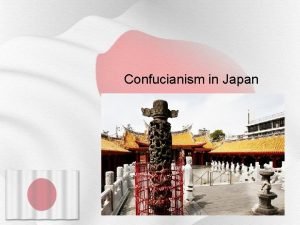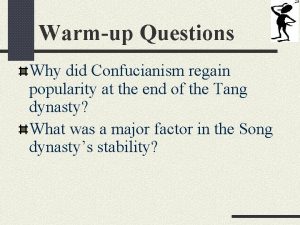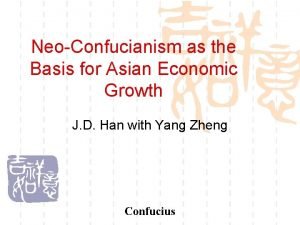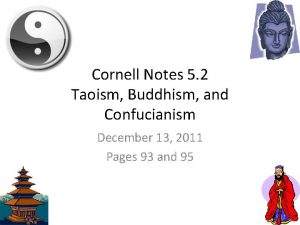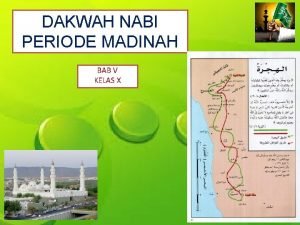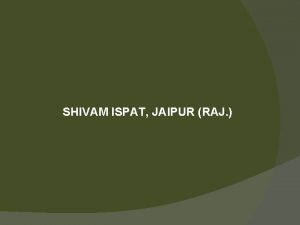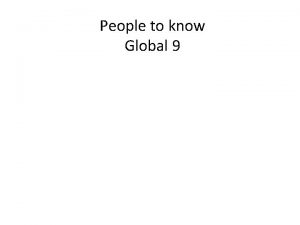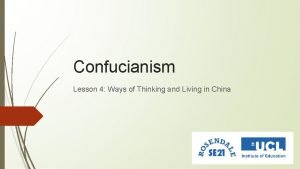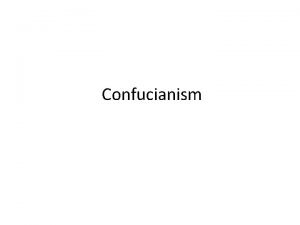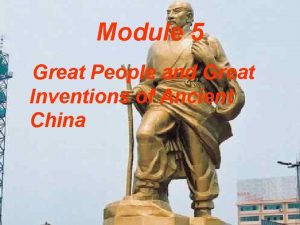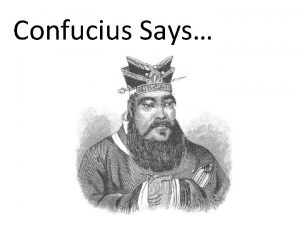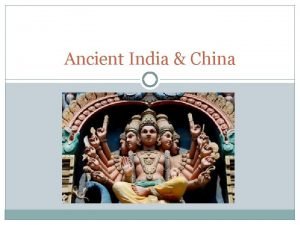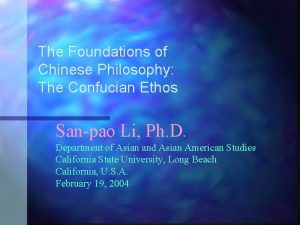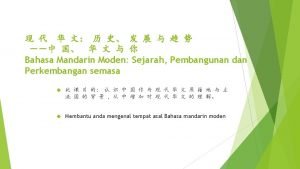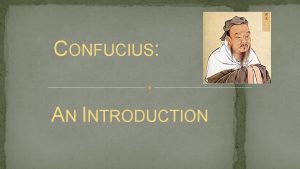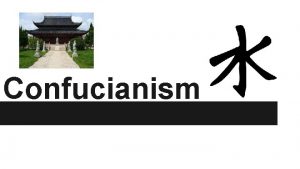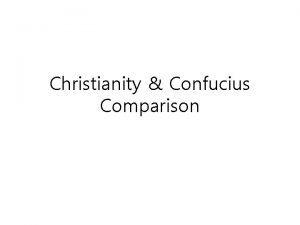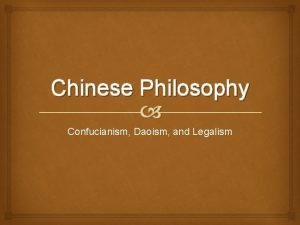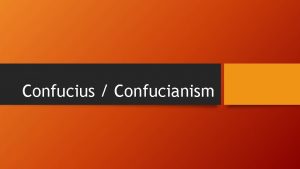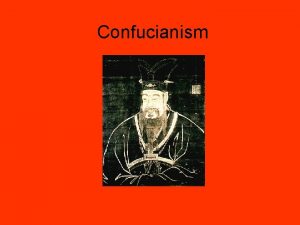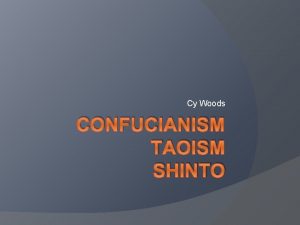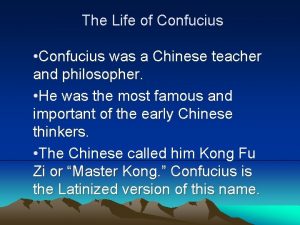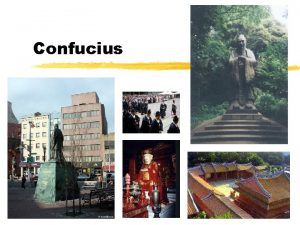Confucianism Anthony DIippilitos Hamzah Hassan Shivam Patel Confucius
















- Slides: 16

Confucianism Anthony D’Iippilitos Hamzah Hassan Shivam Patel

Confucius ● ● ● Founder of Confucianism Kong Qui or Kongzi or Zhongi or Kong Fuzi 551 to c. 479 BCE Known as Confucius; his Latinized name Confucius was a Chinese teacher, editor, politician, and philosopher of the Spring and Autumn period of Chinese history

Basic Beliefs of Confucianism ● ● All people are good You should respect and follow your elders Ancestors should be worshipped Education should be emphasized as it will help you decide between right and wrong ● Yin and Yang represent opposite forces that balance out everything in life

Virtues of Confucianism ● There are 5 main virtues in Confucianism ● 1: Ren, which is humaneness; Humaneness can be defined as the quality of compassion for others, which can include both people and animals. Three of the key concepts of Ren are love, mercy, and humanity. ● 2: Yi. Yi means honesty and righteousness. ● 3: Li, which means propriety and correct behavior. ● 4: Zhi, which stands for wisdom or knowledge. ● 5: Xin, which stands for fidelity and sincerity.

The Five Relationships Believed that social harmony results in part from every individual knowing his or her place in the natural order, and playing his or her part well ● ● ● Ruler/Subject Father/Son Husband/Wife Older Brother/Younger Brother Friend/Friend

Sacred Texts ● The Analects(Lunyu)- Conversations between Confucius and disciples, recollections of life, and sayings (assembled by disciples after Confucius’ death) ● The Analects transmitted “the way”, a concept that at the time symbolized the Western Zhou (1046 -771 BCE) ideology and traditions ● Five Classics (Wujing)- Of Western Zhou Origin ● Later a collection of books were grouped together, known as the Four Books - Great Learning, Doctrine of the Mean, Analects, Mencius

Origins of Confucianism ● Originated in China ● A family of traditions based on Confucius’ teachings that became well known after his death in the fifth century BCE ● Originated as an “ethicalsociopolitical teaching during the Spring and Autumn Period (771476 BCE)

Turning Point: Qin Dynasty ● The Qin dynasty was very short, 221 BCE- 206 BCE ● Unified China under harsh penal laws and ruthlessly putting down rebellions ● The promotion of Legalism by the First Emperor (Shi Huangdi) suppressed Confucianism ● The First Emperor ordered the burning of all books advocating viewpoints that challenged Legalism or the state, this included Confucian material ● Confucianism restrained and put down during this dynasty

Turning Point: The Han Dynasty ● The Han emperors encouraged students and future officials to study the Confucian classics ● This encouragement helped Confucianism spread throughout the Han Dynasty ● Emperor Wu establishes the Imperial Academy which further spreads Confucianism ● A theological and metaphysical doctrine of interaction between Heaven and humans was established ● Since the Han Dynasty until the Twentieth Century, Confucian scholarofficials were influential in laying down the basis for government, and the amount of influence exerted by them depended on the patronage of the people who were in position to implement the teachings

Turning Point- Neo Confucianism ● Influenced by Confucianism ● Was an attempt to create a more rationalist form of Confucianism by rejecting the superstitious and mystical elements of Taoism and Buddhism ● Even though critical of them, Neo Confucianists borrowed ideas from both Buddhism and Daoism ● Used metaphysics as a guide for developing ethical philosophy ● Metaphysics- basically answer What is ultimately there? and What is it like?

Neo-Confucianism ● Originated in the Tang Dynasty and became prominent during the Song and Ming dynasties (960 -1279 CE)(1368 -1644 CE) ● This period and its new teachings/traditions called “Neo-Confucian” to distinguish from other Confucian periods ● A renaissance in which new traditions arose ● Confucianism most forcefully/successfully spread into Korea, Japan, and Vietnam ● Sacred texts grown to include thirteen other works

Confucianism vs. Taoism ● Both originate in China ● Both arise approximately 550 B. C. E ● Both follow The Way, For Confucianism, it was a way to bring out an inner humanity, while for Taoism, it was meditation, breathing techniques ● Many Confucianists and Taoists both follow Buddha ● Confucianism stresses human conduct over belief in God ● Taoism stresses humanity’s relationship with nature

Modern Confucianism ● Confucianism today still believes in the basic beliefs taught by Confucius ● Today Confucianism is more of a mixture between Confucianism, Daoism, and Buddhism than Classical Confucianism.

Confucianism Today ● Today, Confucianism has around 6. 3 million followers ● It is mainly practiced in China, Korea, and Vietnam ● Over 350 million follow the teachings of Confucius.

Bibliography ● http: //www. patheos. com/Library/Confucianism. html ● http: //www. ancient. eu/Confucianism/ ● http: //www. religionfacts. com/a-z-religionindex/confucianism. htm

Bibliography An Introduction to Confucianism by Xinzhong Yao http: //books. google. com/books? id=t. AE 2 OJ 9 b. PG 0 C&pg=PA 81&lpg=PA 81&dq= Turning+points+for+Han+dynasty+confucianism&source=bl&ots=hhmo_y. U 7 AK&sig=Aehk. Cp. Z 9 Yt 93 JThqr. Ttrzb. P ZTOQ&hl=en&sa=X&ei=Kk. VEVMOOJYi 0 y. ATrro. Lg. Cg&ved=0 CB 4 Q 6 AEw. AA#v =onepage&q=Turning%20 points%20 for%20 Han%20 dynasty%20 confucianism&f=false
 Neo confucianism vs confucianism
Neo confucianism vs confucianism Neo confucianism vs confucianism
Neo confucianism vs confucianism Neo confucianism vs confucianism
Neo confucianism vs confucianism Confucianism vs taoism
Confucianism vs taoism Hamzah bin abdul muthalib dipersaudarakan dengan
Hamzah bin abdul muthalib dipersaudarakan dengan Shivam ispat
Shivam ispat Pick the odd man out stv xya
Pick the odd man out stv xya Ancient china confucius
Ancient china confucius Confucius values
Confucius values Confucianism peace
Confucianism peace Confucius teachings
Confucius teachings Confucius says
Confucius says Ancient china map
Ancient china map Confucius values
Confucius values Dinasti zhou
Dinasti zhou What is a sage in confucianism
What is a sage in confucianism Confucius institute at moscow state linguistic university
Confucius institute at moscow state linguistic university
